Health Assessment Case Study: Analyzing Mr. Smith's Healthcare Needs
VerifiedAdded on 2023/01/16
|7
|1952
|83
Case Study
AI Summary
This case study presents a comprehensive health assessment of Mr. Ernest Smith, an elderly patient admitted to the hospital. The assessment begins with an analysis of his vital signs, revealing hypertension, tachycardia, tachypnea, and fever. The study delves into the potential causes and implications of these conditions, including the impact of aging. It outlines recommended interventions, such as medication for fever and hypertension, fluid restrictions, and bronchodilators. Furthermore, the case study identifies Mr. Smith's healthcare needs, considering his age and potential for falls. The study emphasizes the importance of addressing his physiological, psychological, and spiritual needs to improve his quality of life. It concludes with a summary of the patient's health status and the importance of appropriate medical interventions.
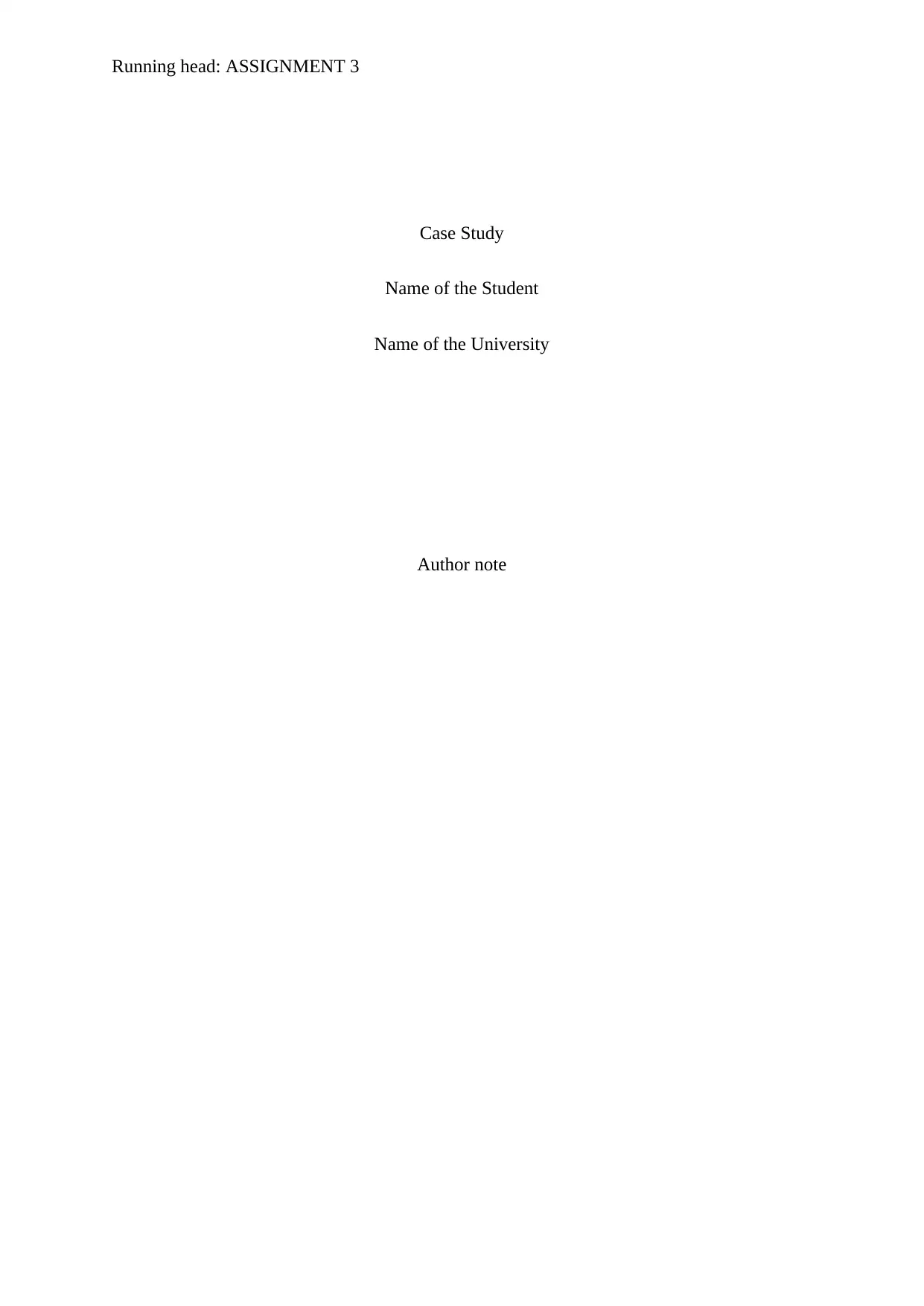
Running head: ASSIGNMENT 3
Case Study
Name of the Student
Name of the University
Author note
Case Study
Name of the Student
Name of the University
Author note
Paraphrase This Document
Need a fresh take? Get an instant paraphrase of this document with our AI Paraphraser
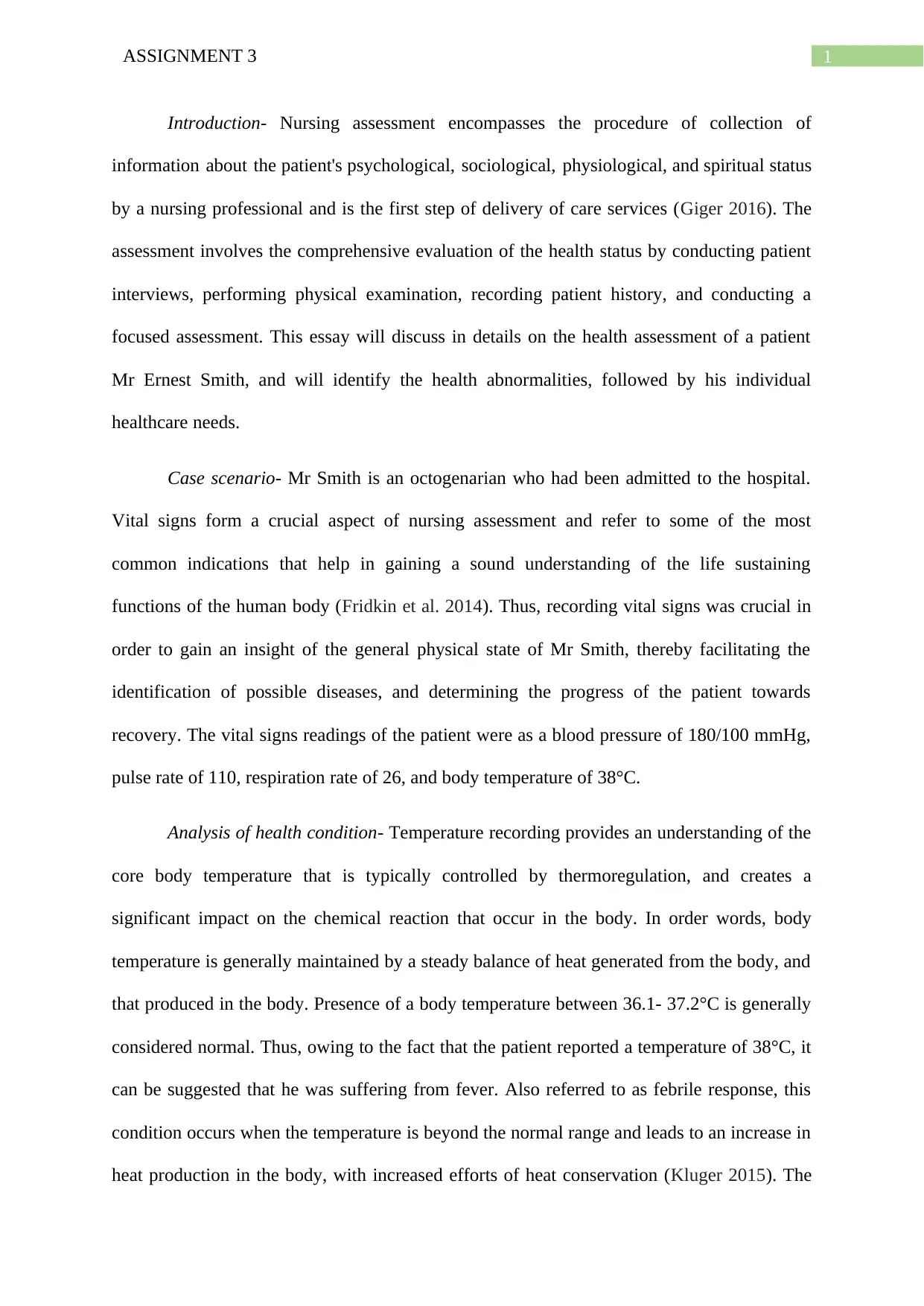
1ASSIGNMENT 3
Introduction- Nursing assessment encompasses the procedure of collection of
information about the patient's psychological, sociological, physiological, and spiritual status
by a nursing professional and is the first step of delivery of care services (Giger 2016). The
assessment involves the comprehensive evaluation of the health status by conducting patient
interviews, performing physical examination, recording patient history, and conducting a
focused assessment. This essay will discuss in details on the health assessment of a patient
Mr Ernest Smith, and will identify the health abnormalities, followed by his individual
healthcare needs.
Case scenario- Mr Smith is an octogenarian who had been admitted to the hospital.
Vital signs form a crucial aspect of nursing assessment and refer to some of the most
common indications that help in gaining a sound understanding of the life sustaining
functions of the human body (Fridkin et al. 2014). Thus, recording vital signs was crucial in
order to gain an insight of the general physical state of Mr Smith, thereby facilitating the
identification of possible diseases, and determining the progress of the patient towards
recovery. The vital signs readings of the patient were as a blood pressure of 180/100 mmHg,
pulse rate of 110, respiration rate of 26, and body temperature of 38°C.
Analysis of health condition- Temperature recording provides an understanding of the
core body temperature that is typically controlled by thermoregulation, and creates a
significant impact on the chemical reaction that occur in the body. In order words, body
temperature is generally maintained by a steady balance of heat generated from the body, and
that produced in the body. Presence of a body temperature between 36.1- 37.2°C is generally
considered normal. Thus, owing to the fact that the patient reported a temperature of 38°C, it
can be suggested that he was suffering from fever. Also referred to as febrile response, this
condition occurs when the temperature is beyond the normal range and leads to an increase in
heat production in the body, with increased efforts of heat conservation (Kluger 2015). The
Introduction- Nursing assessment encompasses the procedure of collection of
information about the patient's psychological, sociological, physiological, and spiritual status
by a nursing professional and is the first step of delivery of care services (Giger 2016). The
assessment involves the comprehensive evaluation of the health status by conducting patient
interviews, performing physical examination, recording patient history, and conducting a
focused assessment. This essay will discuss in details on the health assessment of a patient
Mr Ernest Smith, and will identify the health abnormalities, followed by his individual
healthcare needs.
Case scenario- Mr Smith is an octogenarian who had been admitted to the hospital.
Vital signs form a crucial aspect of nursing assessment and refer to some of the most
common indications that help in gaining a sound understanding of the life sustaining
functions of the human body (Fridkin et al. 2014). Thus, recording vital signs was crucial in
order to gain an insight of the general physical state of Mr Smith, thereby facilitating the
identification of possible diseases, and determining the progress of the patient towards
recovery. The vital signs readings of the patient were as a blood pressure of 180/100 mmHg,
pulse rate of 110, respiration rate of 26, and body temperature of 38°C.
Analysis of health condition- Temperature recording provides an understanding of the
core body temperature that is typically controlled by thermoregulation, and creates a
significant impact on the chemical reaction that occur in the body. In order words, body
temperature is generally maintained by a steady balance of heat generated from the body, and
that produced in the body. Presence of a body temperature between 36.1- 37.2°C is generally
considered normal. Thus, owing to the fact that the patient reported a temperature of 38°C, it
can be suggested that he was suffering from fever. Also referred to as febrile response, this
condition occurs when the temperature is beyond the normal range and leads to an increase in
heat production in the body, with increased efforts of heat conservation (Kluger 2015). The
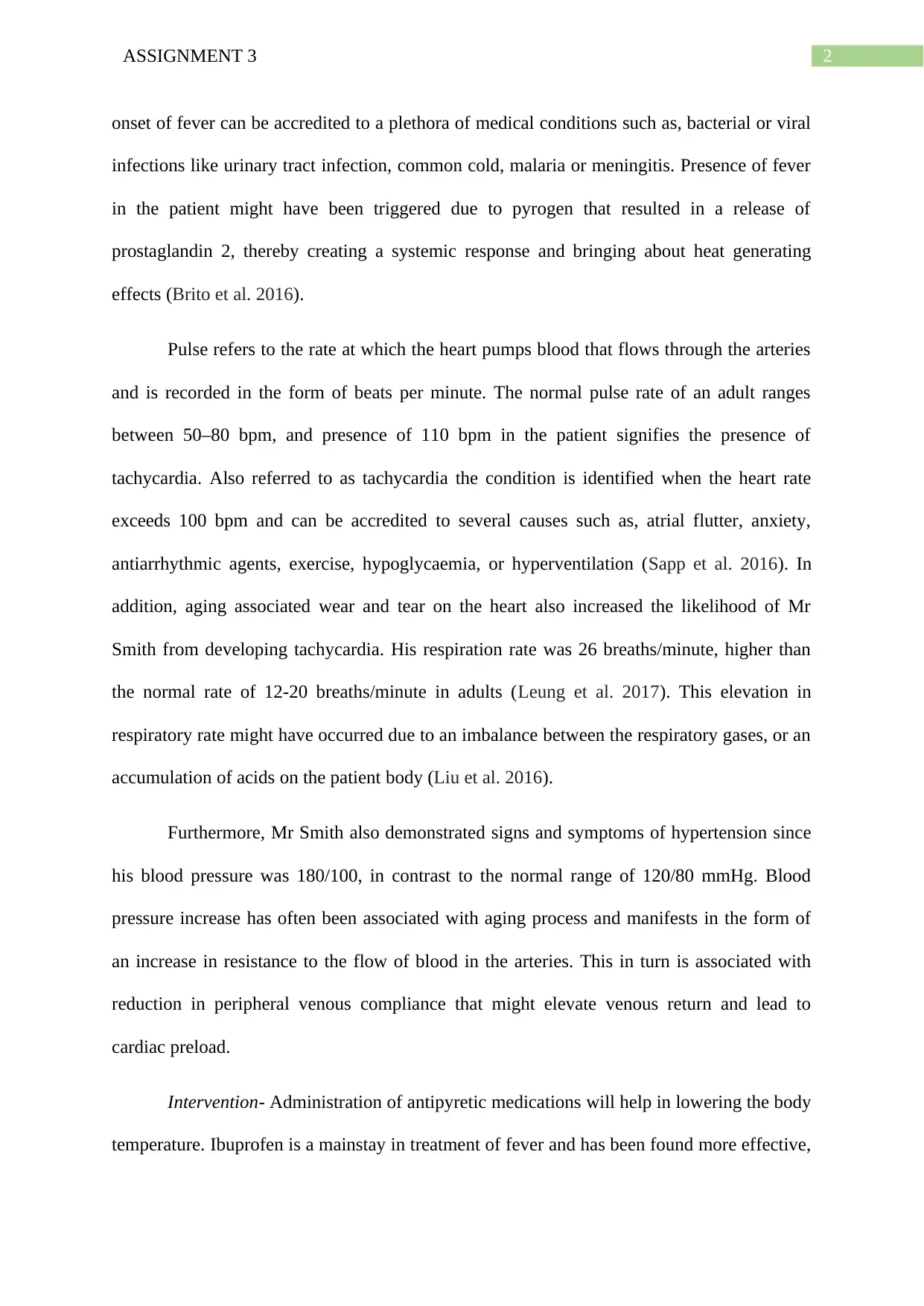
2ASSIGNMENT 3
onset of fever can be accredited to a plethora of medical conditions such as, bacterial or viral
infections like urinary tract infection, common cold, malaria or meningitis. Presence of fever
in the patient might have been triggered due to pyrogen that resulted in a release of
prostaglandin 2, thereby creating a systemic response and bringing about heat generating
effects (Brito et al. 2016).
Pulse refers to the rate at which the heart pumps blood that flows through the arteries
and is recorded in the form of beats per minute. The normal pulse rate of an adult ranges
between 50–80 bpm, and presence of 110 bpm in the patient signifies the presence of
tachycardia. Also referred to as tachycardia the condition is identified when the heart rate
exceeds 100 bpm and can be accredited to several causes such as, atrial flutter, anxiety,
antiarrhythmic agents, exercise, hypoglycaemia, or hyperventilation (Sapp et al. 2016). In
addition, aging associated wear and tear on the heart also increased the likelihood of Mr
Smith from developing tachycardia. His respiration rate was 26 breaths/minute, higher than
the normal rate of 12-20 breaths/minute in adults (Leung et al. 2017). This elevation in
respiratory rate might have occurred due to an imbalance between the respiratory gases, or an
accumulation of acids on the patient body (Liu et al. 2016).
Furthermore, Mr Smith also demonstrated signs and symptoms of hypertension since
his blood pressure was 180/100, in contrast to the normal range of 120/80 mmHg. Blood
pressure increase has often been associated with aging process and manifests in the form of
an increase in resistance to the flow of blood in the arteries. This in turn is associated with
reduction in peripheral venous compliance that might elevate venous return and lead to
cardiac preload.
Intervention- Administration of antipyretic medications will help in lowering the body
temperature. Ibuprofen is a mainstay in treatment of fever and has been found more effective,
onset of fever can be accredited to a plethora of medical conditions such as, bacterial or viral
infections like urinary tract infection, common cold, malaria or meningitis. Presence of fever
in the patient might have been triggered due to pyrogen that resulted in a release of
prostaglandin 2, thereby creating a systemic response and bringing about heat generating
effects (Brito et al. 2016).
Pulse refers to the rate at which the heart pumps blood that flows through the arteries
and is recorded in the form of beats per minute. The normal pulse rate of an adult ranges
between 50–80 bpm, and presence of 110 bpm in the patient signifies the presence of
tachycardia. Also referred to as tachycardia the condition is identified when the heart rate
exceeds 100 bpm and can be accredited to several causes such as, atrial flutter, anxiety,
antiarrhythmic agents, exercise, hypoglycaemia, or hyperventilation (Sapp et al. 2016). In
addition, aging associated wear and tear on the heart also increased the likelihood of Mr
Smith from developing tachycardia. His respiration rate was 26 breaths/minute, higher than
the normal rate of 12-20 breaths/minute in adults (Leung et al. 2017). This elevation in
respiratory rate might have occurred due to an imbalance between the respiratory gases, or an
accumulation of acids on the patient body (Liu et al. 2016).
Furthermore, Mr Smith also demonstrated signs and symptoms of hypertension since
his blood pressure was 180/100, in contrast to the normal range of 120/80 mmHg. Blood
pressure increase has often been associated with aging process and manifests in the form of
an increase in resistance to the flow of blood in the arteries. This in turn is associated with
reduction in peripheral venous compliance that might elevate venous return and lead to
cardiac preload.
Intervention- Administration of antipyretic medications will help in lowering the body
temperature. Ibuprofen is a mainstay in treatment of fever and has been found more effective,
⊘ This is a preview!⊘
Do you want full access?
Subscribe today to unlock all pages.

Trusted by 1+ million students worldwide
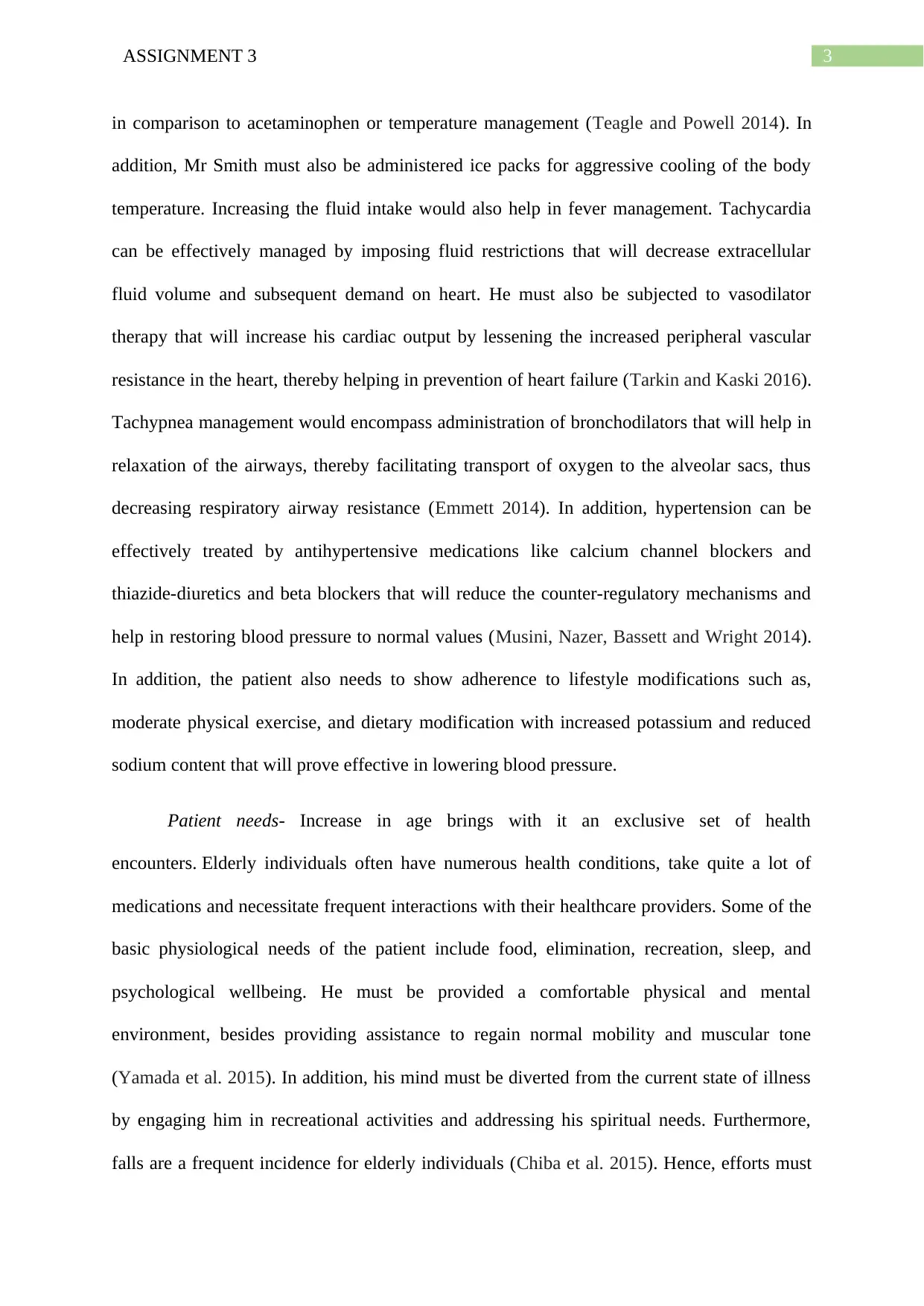
3ASSIGNMENT 3
in comparison to acetaminophen or temperature management (Teagle and Powell 2014). In
addition, Mr Smith must also be administered ice packs for aggressive cooling of the body
temperature. Increasing the fluid intake would also help in fever management. Tachycardia
can be effectively managed by imposing fluid restrictions that will decrease extracellular
fluid volume and subsequent demand on heart. He must also be subjected to vasodilator
therapy that will increase his cardiac output by lessening the increased peripheral vascular
resistance in the heart, thereby helping in prevention of heart failure (Tarkin and Kaski 2016).
Tachypnea management would encompass administration of bronchodilators that will help in
relaxation of the airways, thereby facilitating transport of oxygen to the alveolar sacs, thus
decreasing respiratory airway resistance (Emmett 2014). In addition, hypertension can be
effectively treated by antihypertensive medications like calcium channel blockers and
thiazide-diuretics and beta blockers that will reduce the counter-regulatory mechanisms and
help in restoring blood pressure to normal values (Musini, Nazer, Bassett and Wright 2014).
In addition, the patient also needs to show adherence to lifestyle modifications such as,
moderate physical exercise, and dietary modification with increased potassium and reduced
sodium content that will prove effective in lowering blood pressure.
Patient needs- Increase in age brings with it an exclusive set of health
encounters. Elderly individuals often have numerous health conditions, take quite a lot of
medications and necessitate frequent interactions with their healthcare providers. Some of the
basic physiological needs of the patient include food, elimination, recreation, sleep, and
psychological wellbeing. He must be provided a comfortable physical and mental
environment, besides providing assistance to regain normal mobility and muscular tone
(Yamada et al. 2015). In addition, his mind must be diverted from the current state of illness
by engaging him in recreational activities and addressing his spiritual needs. Furthermore,
falls are a frequent incidence for elderly individuals (Chiba et al. 2015). Hence, efforts must
in comparison to acetaminophen or temperature management (Teagle and Powell 2014). In
addition, Mr Smith must also be administered ice packs for aggressive cooling of the body
temperature. Increasing the fluid intake would also help in fever management. Tachycardia
can be effectively managed by imposing fluid restrictions that will decrease extracellular
fluid volume and subsequent demand on heart. He must also be subjected to vasodilator
therapy that will increase his cardiac output by lessening the increased peripheral vascular
resistance in the heart, thereby helping in prevention of heart failure (Tarkin and Kaski 2016).
Tachypnea management would encompass administration of bronchodilators that will help in
relaxation of the airways, thereby facilitating transport of oxygen to the alveolar sacs, thus
decreasing respiratory airway resistance (Emmett 2014). In addition, hypertension can be
effectively treated by antihypertensive medications like calcium channel blockers and
thiazide-diuretics and beta blockers that will reduce the counter-regulatory mechanisms and
help in restoring blood pressure to normal values (Musini, Nazer, Bassett and Wright 2014).
In addition, the patient also needs to show adherence to lifestyle modifications such as,
moderate physical exercise, and dietary modification with increased potassium and reduced
sodium content that will prove effective in lowering blood pressure.
Patient needs- Increase in age brings with it an exclusive set of health
encounters. Elderly individuals often have numerous health conditions, take quite a lot of
medications and necessitate frequent interactions with their healthcare providers. Some of the
basic physiological needs of the patient include food, elimination, recreation, sleep, and
psychological wellbeing. He must be provided a comfortable physical and mental
environment, besides providing assistance to regain normal mobility and muscular tone
(Yamada et al. 2015). In addition, his mind must be diverted from the current state of illness
by engaging him in recreational activities and addressing his spiritual needs. Furthermore,
falls are a frequent incidence for elderly individuals (Chiba et al. 2015). Hence, efforts must
Paraphrase This Document
Need a fresh take? Get an instant paraphrase of this document with our AI Paraphraser
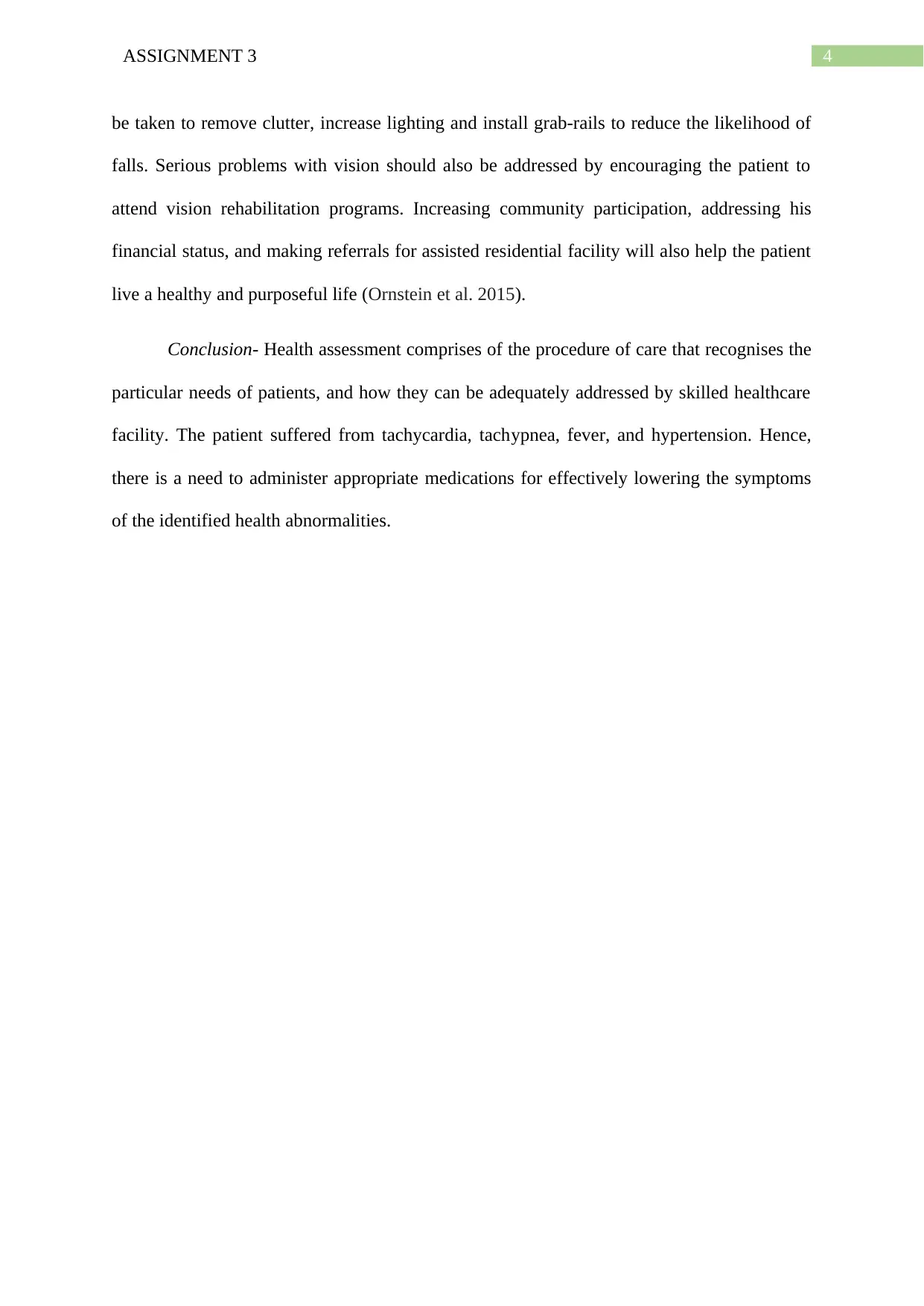
4ASSIGNMENT 3
be taken to remove clutter, increase lighting and install grab-rails to reduce the likelihood of
falls. Serious problems with vision should also be addressed by encouraging the patient to
attend vision rehabilitation programs. Increasing community participation, addressing his
financial status, and making referrals for assisted residential facility will also help the patient
live a healthy and purposeful life (Ornstein et al. 2015).
Conclusion- Health assessment comprises of the procedure of care that recognises the
particular needs of patients, and how they can be adequately addressed by skilled healthcare
facility. The patient suffered from tachycardia, tachypnea, fever, and hypertension. Hence,
there is a need to administer appropriate medications for effectively lowering the symptoms
of the identified health abnormalities.
be taken to remove clutter, increase lighting and install grab-rails to reduce the likelihood of
falls. Serious problems with vision should also be addressed by encouraging the patient to
attend vision rehabilitation programs. Increasing community participation, addressing his
financial status, and making referrals for assisted residential facility will also help the patient
live a healthy and purposeful life (Ornstein et al. 2015).
Conclusion- Health assessment comprises of the procedure of care that recognises the
particular needs of patients, and how they can be adequately addressed by skilled healthcare
facility. The patient suffered from tachycardia, tachypnea, fever, and hypertension. Hence,
there is a need to administer appropriate medications for effectively lowering the symptoms
of the identified health abnormalities.
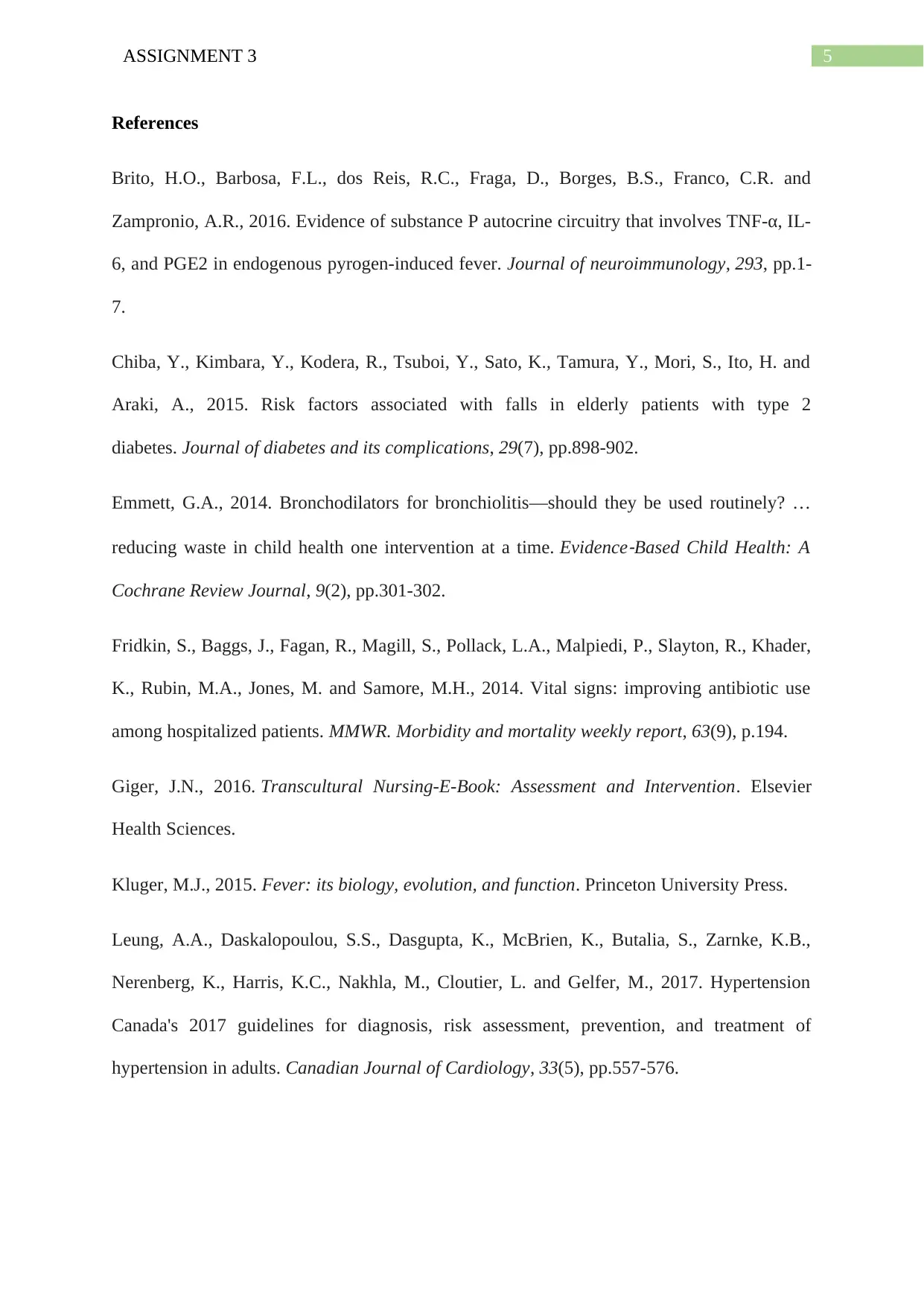
5ASSIGNMENT 3
References
Brito, H.O., Barbosa, F.L., dos Reis, R.C., Fraga, D., Borges, B.S., Franco, C.R. and
Zampronio, A.R., 2016. Evidence of substance P autocrine circuitry that involves TNF-α, IL-
6, and PGE2 in endogenous pyrogen-induced fever. Journal of neuroimmunology, 293, pp.1-
7.
Chiba, Y., Kimbara, Y., Kodera, R., Tsuboi, Y., Sato, K., Tamura, Y., Mori, S., Ito, H. and
Araki, A., 2015. Risk factors associated with falls in elderly patients with type 2
diabetes. Journal of diabetes and its complications, 29(7), pp.898-902.
Emmett, G.A., 2014. Bronchodilators for bronchiolitis—should they be used routinely? …
reducing waste in child health one intervention at a time. Evidence
‐Based Child Health: A
Cochrane Review Journal, 9(2), pp.301-302.
Fridkin, S., Baggs, J., Fagan, R., Magill, S., Pollack, L.A., Malpiedi, P., Slayton, R., Khader,
K., Rubin, M.A., Jones, M. and Samore, M.H., 2014. Vital signs: improving antibiotic use
among hospitalized patients. MMWR. Morbidity and mortality weekly report, 63(9), p.194.
Giger, J.N., 2016. Transcultural Nursing-E-Book: Assessment and Intervention. Elsevier
Health Sciences.
Kluger, M.J., 2015. Fever: its biology, evolution, and function. Princeton University Press.
Leung, A.A., Daskalopoulou, S.S., Dasgupta, K., McBrien, K., Butalia, S., Zarnke, K.B.,
Nerenberg, K., Harris, K.C., Nakhla, M., Cloutier, L. and Gelfer, M., 2017. Hypertension
Canada's 2017 guidelines for diagnosis, risk assessment, prevention, and treatment of
hypertension in adults. Canadian Journal of Cardiology, 33(5), pp.557-576.
References
Brito, H.O., Barbosa, F.L., dos Reis, R.C., Fraga, D., Borges, B.S., Franco, C.R. and
Zampronio, A.R., 2016. Evidence of substance P autocrine circuitry that involves TNF-α, IL-
6, and PGE2 in endogenous pyrogen-induced fever. Journal of neuroimmunology, 293, pp.1-
7.
Chiba, Y., Kimbara, Y., Kodera, R., Tsuboi, Y., Sato, K., Tamura, Y., Mori, S., Ito, H. and
Araki, A., 2015. Risk factors associated with falls in elderly patients with type 2
diabetes. Journal of diabetes and its complications, 29(7), pp.898-902.
Emmett, G.A., 2014. Bronchodilators for bronchiolitis—should they be used routinely? …
reducing waste in child health one intervention at a time. Evidence
‐Based Child Health: A
Cochrane Review Journal, 9(2), pp.301-302.
Fridkin, S., Baggs, J., Fagan, R., Magill, S., Pollack, L.A., Malpiedi, P., Slayton, R., Khader,
K., Rubin, M.A., Jones, M. and Samore, M.H., 2014. Vital signs: improving antibiotic use
among hospitalized patients. MMWR. Morbidity and mortality weekly report, 63(9), p.194.
Giger, J.N., 2016. Transcultural Nursing-E-Book: Assessment and Intervention. Elsevier
Health Sciences.
Kluger, M.J., 2015. Fever: its biology, evolution, and function. Princeton University Press.
Leung, A.A., Daskalopoulou, S.S., Dasgupta, K., McBrien, K., Butalia, S., Zarnke, K.B.,
Nerenberg, K., Harris, K.C., Nakhla, M., Cloutier, L. and Gelfer, M., 2017. Hypertension
Canada's 2017 guidelines for diagnosis, risk assessment, prevention, and treatment of
hypertension in adults. Canadian Journal of Cardiology, 33(5), pp.557-576.
⊘ This is a preview!⊘
Do you want full access?
Subscribe today to unlock all pages.

Trusted by 1+ million students worldwide
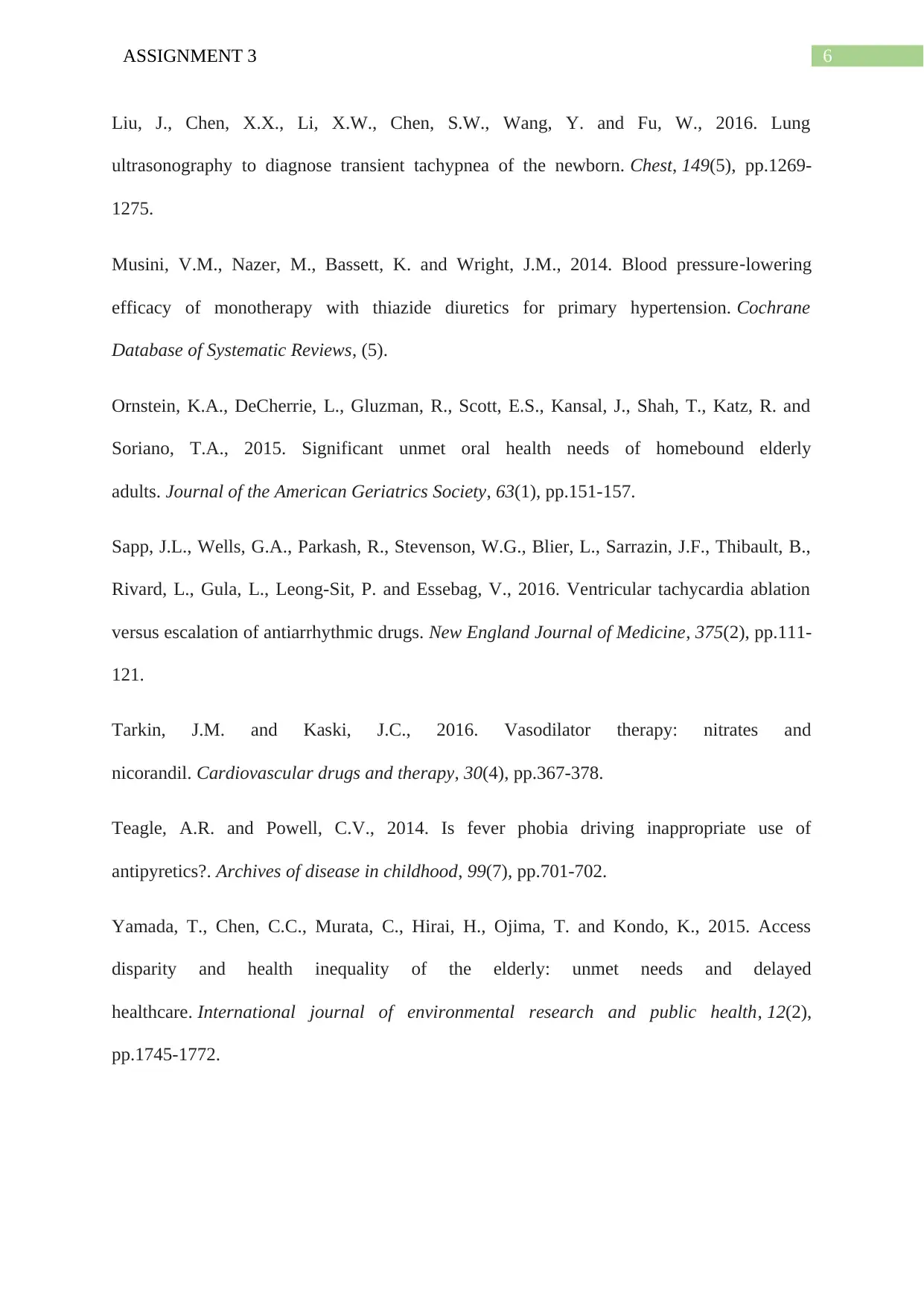
6ASSIGNMENT 3
Liu, J., Chen, X.X., Li, X.W., Chen, S.W., Wang, Y. and Fu, W., 2016. Lung
ultrasonography to diagnose transient tachypnea of the newborn. Chest, 149(5), pp.1269-
1275.
Musini, V.M., Nazer, M., Bassett, K. and Wright, J.M., 2014. Blood pressure‐lowering
efficacy of monotherapy with thiazide diuretics for primary hypertension. Cochrane
Database of Systematic Reviews, (5).
Ornstein, K.A., DeCherrie, L., Gluzman, R., Scott, E.S., Kansal, J., Shah, T., Katz, R. and
Soriano, T.A., 2015. Significant unmet oral health needs of homebound elderly
adults. Journal of the American Geriatrics Society, 63(1), pp.151-157.
Sapp, J.L., Wells, G.A., Parkash, R., Stevenson, W.G., Blier, L., Sarrazin, J.F., Thibault, B.,
Rivard, L., Gula, L., Leong-Sit, P. and Essebag, V., 2016. Ventricular tachycardia ablation
versus escalation of antiarrhythmic drugs. New England Journal of Medicine, 375(2), pp.111-
121.
Tarkin, J.M. and Kaski, J.C., 2016. Vasodilator therapy: nitrates and
nicorandil. Cardiovascular drugs and therapy, 30(4), pp.367-378.
Teagle, A.R. and Powell, C.V., 2014. Is fever phobia driving inappropriate use of
antipyretics?. Archives of disease in childhood, 99(7), pp.701-702.
Yamada, T., Chen, C.C., Murata, C., Hirai, H., Ojima, T. and Kondo, K., 2015. Access
disparity and health inequality of the elderly: unmet needs and delayed
healthcare. International journal of environmental research and public health, 12(2),
pp.1745-1772.
Liu, J., Chen, X.X., Li, X.W., Chen, S.W., Wang, Y. and Fu, W., 2016. Lung
ultrasonography to diagnose transient tachypnea of the newborn. Chest, 149(5), pp.1269-
1275.
Musini, V.M., Nazer, M., Bassett, K. and Wright, J.M., 2014. Blood pressure‐lowering
efficacy of monotherapy with thiazide diuretics for primary hypertension. Cochrane
Database of Systematic Reviews, (5).
Ornstein, K.A., DeCherrie, L., Gluzman, R., Scott, E.S., Kansal, J., Shah, T., Katz, R. and
Soriano, T.A., 2015. Significant unmet oral health needs of homebound elderly
adults. Journal of the American Geriatrics Society, 63(1), pp.151-157.
Sapp, J.L., Wells, G.A., Parkash, R., Stevenson, W.G., Blier, L., Sarrazin, J.F., Thibault, B.,
Rivard, L., Gula, L., Leong-Sit, P. and Essebag, V., 2016. Ventricular tachycardia ablation
versus escalation of antiarrhythmic drugs. New England Journal of Medicine, 375(2), pp.111-
121.
Tarkin, J.M. and Kaski, J.C., 2016. Vasodilator therapy: nitrates and
nicorandil. Cardiovascular drugs and therapy, 30(4), pp.367-378.
Teagle, A.R. and Powell, C.V., 2014. Is fever phobia driving inappropriate use of
antipyretics?. Archives of disease in childhood, 99(7), pp.701-702.
Yamada, T., Chen, C.C., Murata, C., Hirai, H., Ojima, T. and Kondo, K., 2015. Access
disparity and health inequality of the elderly: unmet needs and delayed
healthcare. International journal of environmental research and public health, 12(2),
pp.1745-1772.
1 out of 7
Related Documents
Your All-in-One AI-Powered Toolkit for Academic Success.
+13062052269
info@desklib.com
Available 24*7 on WhatsApp / Email
![[object Object]](/_next/static/media/star-bottom.7253800d.svg)
Unlock your academic potential
Copyright © 2020–2025 A2Z Services. All Rights Reserved. Developed and managed by ZUCOL.





